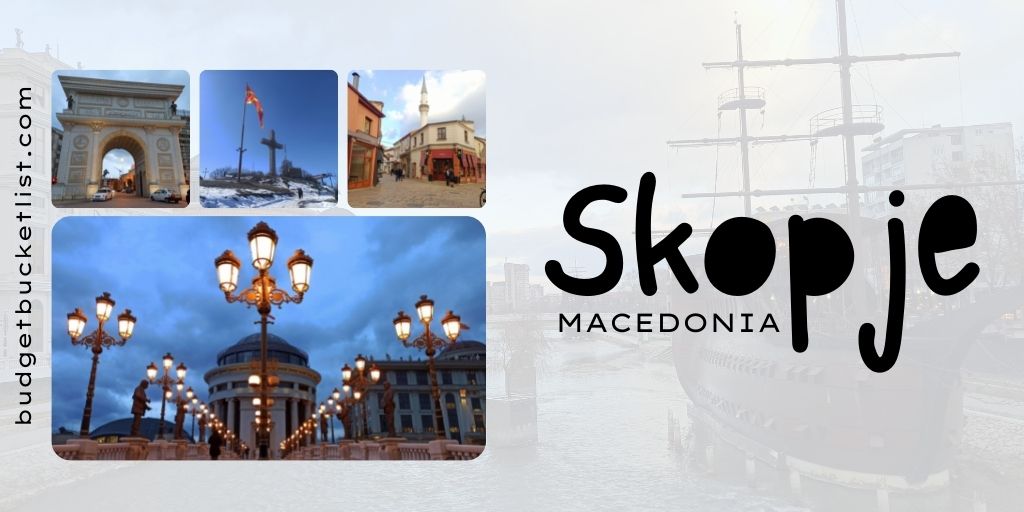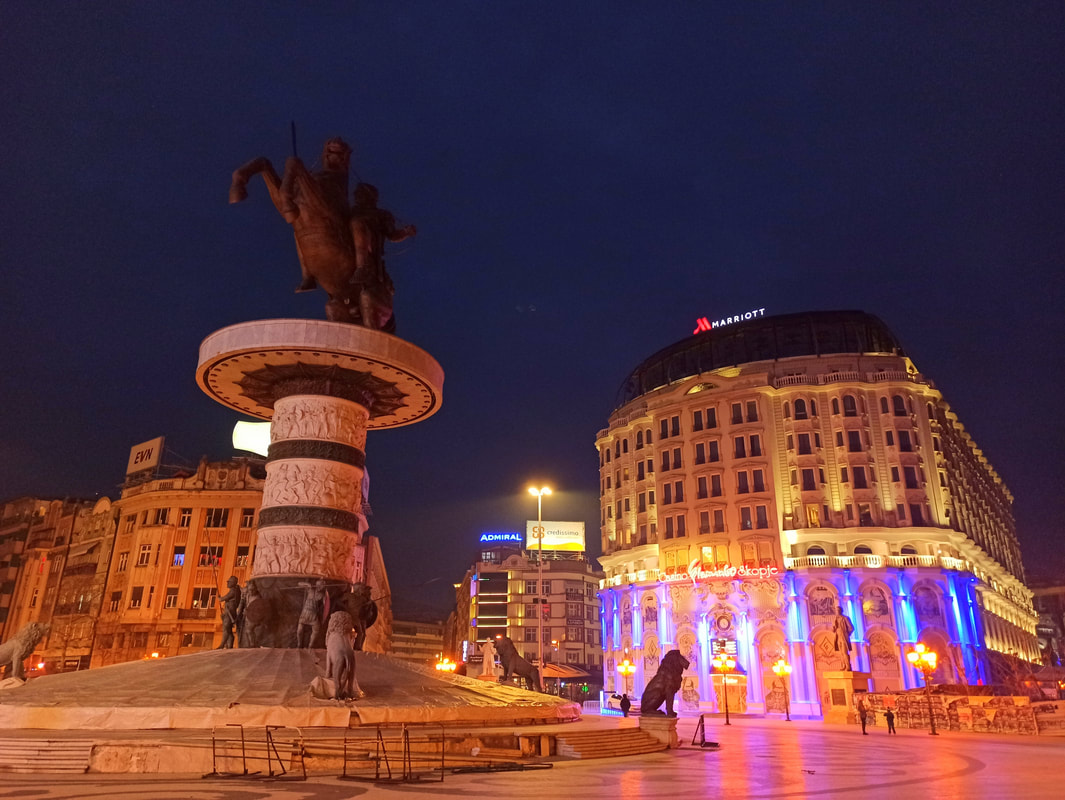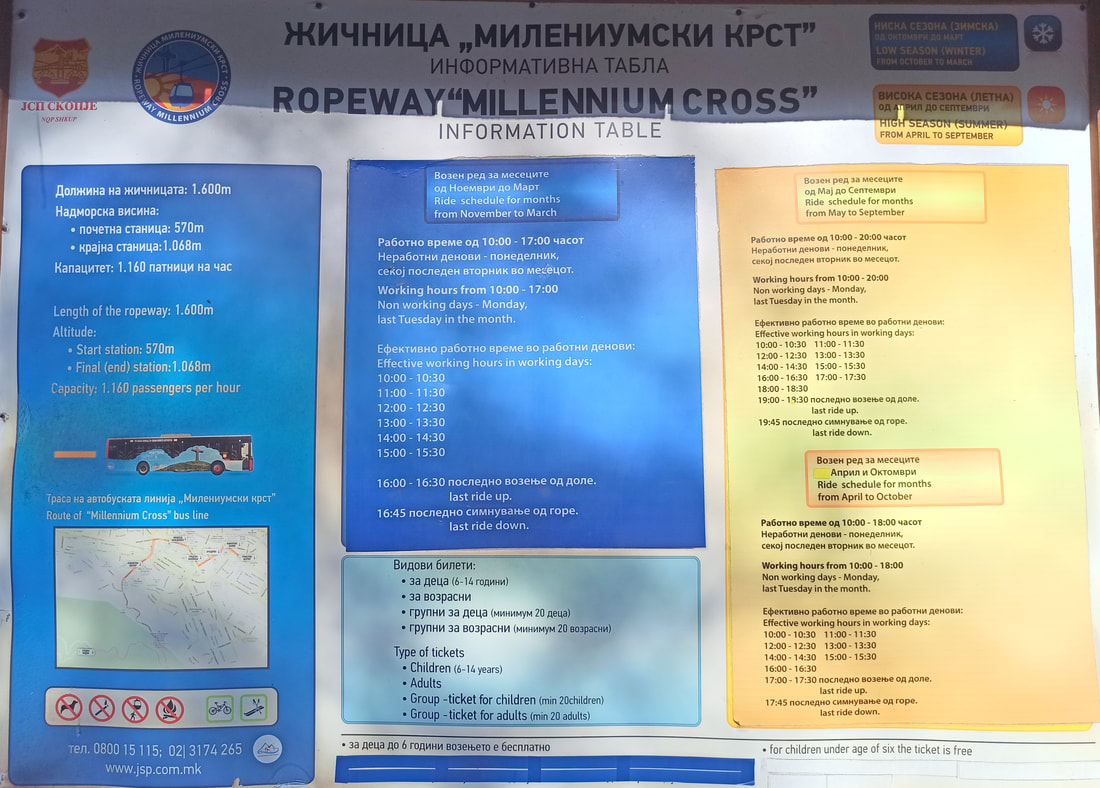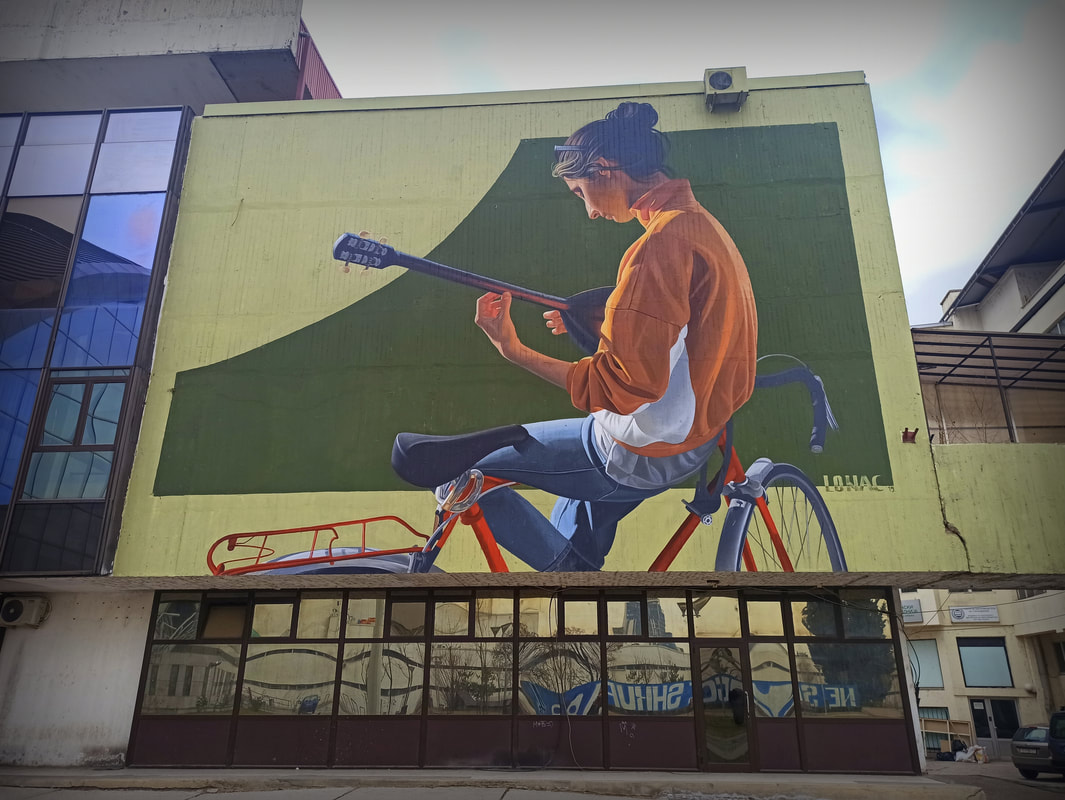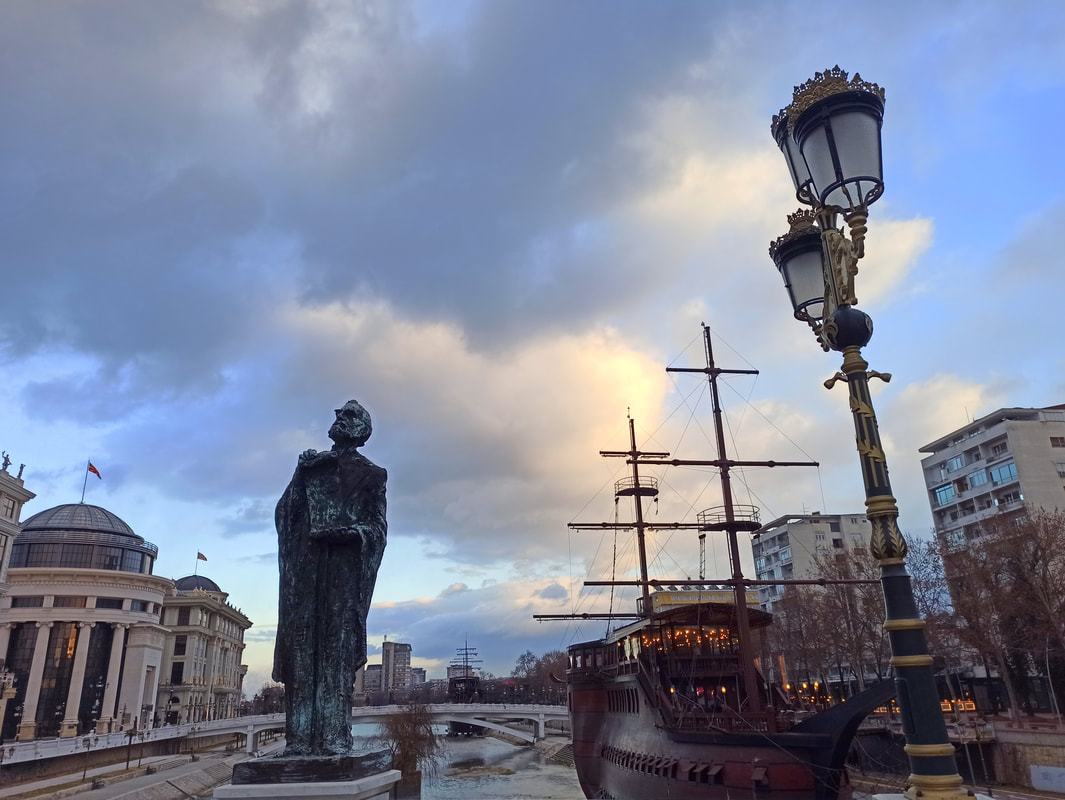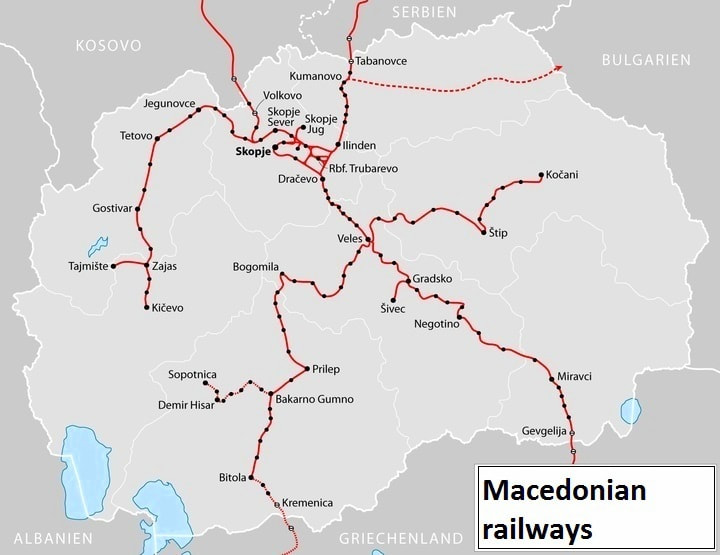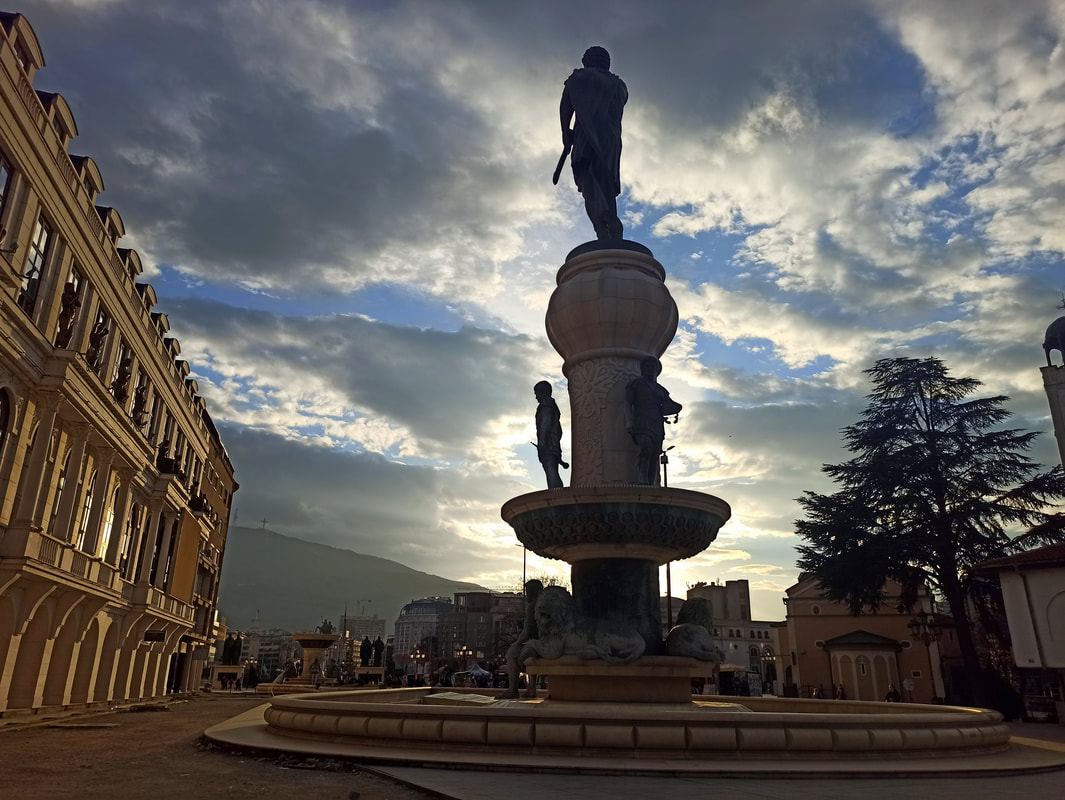Skopje
Not in the story-mood? Scroll down for the Quick Budget Fact Overview: an itemized information summary of Skopje ↓
Any first tourist encounter with Skopje is paired with utter confusion. You see these wide, modern boulevards and squares, at night hysterically lit up by flashing Las-Vegas-style neo-lights… But then there’s also the traditional old Ottoman Bazaar, safeguarding historical influences. Lumpish brutalist architecture somehow goes hand in hand with minarets, neoclassical buildings and random elements of post-modernism. A bunch of pirate ships float on the Vardar River while traffic navigates through a miniature copy of Paris’ Arc de Triomphe. And what’s with all those statues?
Too busy to read now? No problem, save it for later!
Save on Get Pocket | Save in Browser Bookmarks| Save on Instapaper
Save on Get Pocket | Save in Browser Bookmarks| Save on Instapaper
As a result of a catastrophic earthquake in 1963, Skopje’s city council was suddenly faced with the task to re-emerge a new city. It was a tragic event that lead to a chance to re-invent themselves and adjust the urban appearance. The result is the overwhelming mishmash we witness today, confusing but simultaneously amusing. Utterly strange, yet intriguing.
I stayed a full month in Skopje. First of all to sit out Covid in isolation, but also to work, rest and unwind after my recovery. The ongoing list of sights and activities, as well as the budget-friendly cost of living and traveling definitely didn’t hurt. Accommodation and food is affordable, and exploring Skopje’s many attractions is (almost) free! Allow me to elaborate:
Free Sights
Undoubtedly the first thing you’ll notice on any Skopje city walk is the insane amount of statues inhabiting the urban centre. Why?! It’s a result of the ‘Skopje 2014’ project, aimed to increase tourism by giving the capital a more classical appeal while simultaneously imposing the identity and narrative of the country’s history with an unbroken continuity from antiquity until Philip II and his son Alexander the Great. Not sure if that necessarily comes across as intended, but it sure raises an eyebrow or two and is likely to be remembered and retold by any visitor. The highest concentration of statues can be found in the area of the Macedonia Square, the Porta Macedonia* and the city’s main shopping street, which also houses the Church of Mother Teresa. Another element of the project was the construction of the Art and Eye Bridge, as well as the renovation of the Freedom, Goce Delčev and Revolution Bridge. The emblematic Stone Bridge on the other hand goes way further back, as it was built during Ottoman times (under Mehmed II) on top of existing Roman foundations. A great way to see all bridges is by strolling along the Vardar River, which is sided by pleasant pedestrian and bicycle lanes.
* Commemorating 20 years of Macedonian independence.
I stayed a full month in Skopje. First of all to sit out Covid in isolation, but also to work, rest and unwind after my recovery. The ongoing list of sights and activities, as well as the budget-friendly cost of living and traveling definitely didn’t hurt. Accommodation and food is affordable, and exploring Skopje’s many attractions is (almost) free! Allow me to elaborate:
Free Sights
Undoubtedly the first thing you’ll notice on any Skopje city walk is the insane amount of statues inhabiting the urban centre. Why?! It’s a result of the ‘Skopje 2014’ project, aimed to increase tourism by giving the capital a more classical appeal while simultaneously imposing the identity and narrative of the country’s history with an unbroken continuity from antiquity until Philip II and his son Alexander the Great. Not sure if that necessarily comes across as intended, but it sure raises an eyebrow or two and is likely to be remembered and retold by any visitor. The highest concentration of statues can be found in the area of the Macedonia Square, the Porta Macedonia* and the city’s main shopping street, which also houses the Church of Mother Teresa. Another element of the project was the construction of the Art and Eye Bridge, as well as the renovation of the Freedom, Goce Delčev and Revolution Bridge. The emblematic Stone Bridge on the other hand goes way further back, as it was built during Ottoman times (under Mehmed II) on top of existing Roman foundations. A great way to see all bridges is by strolling along the Vardar River, which is sided by pleasant pedestrian and bicycle lanes.
* Commemorating 20 years of Macedonian independence.
Personally, my favorite area in town is the Old Bazaar, the Ottoman-style historical centre living up to all its delightful stereotypes of swirling alleys, hidden shisha-bars and baklava in every corner. The main (free) sights within the Bazaar are the Mustafa Pasha’s Mosque and the Kapan Han, the historical resting place of traveling traders. For a modest entry price it’s also possible to visit the Daut Pasha Hamam, which nowadays houses an art gallery. Make sure to also explore this area at night, as this is the main nightlife district! Another interesting stop bordering the Old Bazaar is the Fortress or Kale, thought to be built by the Byzantine Emperor Justininian I. Over time, the fortress was destroyed and rebuilt numerous times… yet, it was reconstructed only recently after its latest destruction by the 1963 earthquake. Not in a great way, if I may add. It looks a tad shabby and run down, needing that extra bit of love and attention to really accentuate its former glory. That said, the views over the city with the spectacular backdrop of the mountains, which can be obtained from this location, are unparalleled.
Sights slightly outside the centre include the Debar Maalo district, labelled the “bohemian nightlife area” of town. Definitely not your cheapest party option, but sure worth a visit. While there, have a peek at the oddly shaped and therefore oh-so-“Skopjan” Church of St. Clement of Ohrid, as well as the immense City Park… the favorite Sunday hangout for all its inhabitants. Much further out of town you can find the lengthy and well-preserved Roman Aqueduct of Skopje, which is the only one of the sorts in Macedonia. It’s an impressive sight, but the sacrifice of having to walk along a busy, polluted highway kind of ruins the fun.
Free Activities
The most efficient way to check off the majority of the mentioned sights is by means of the Free Skopje Walking Tour*. Needless to say, it’s not entirely free, as a reasonable tip is expected, but it gives you the freedom to pay what you think it was worth. I truly appreciated the efforts and knowledge of our friendly guide Aphrodite, who filled our heads with facts and anecdotes and even arranged a complimentary wine tasting at Wine Berry. Wine Berry can also be visited without participating in the tour and offers a great alternative to visiting all wineries** separately, for which a vehicle is needed (with the complication to drive it sober afterwards). This friendly-run shop offers entirely free tastings of both Macedonian and international wines, without actively pressuring you into buying a bottle. However, odds are high you’ll most definitely want to.
* In off-season, the tours have to be reserved in advance.
** Brzanov Artisan Winery, Kartal Winery and Kamnik Winery.
Free Activities
The most efficient way to check off the majority of the mentioned sights is by means of the Free Skopje Walking Tour*. Needless to say, it’s not entirely free, as a reasonable tip is expected, but it gives you the freedom to pay what you think it was worth. I truly appreciated the efforts and knowledge of our friendly guide Aphrodite, who filled our heads with facts and anecdotes and even arranged a complimentary wine tasting at Wine Berry. Wine Berry can also be visited without participating in the tour and offers a great alternative to visiting all wineries** separately, for which a vehicle is needed (with the complication to drive it sober afterwards). This friendly-run shop offers entirely free tastings of both Macedonian and international wines, without actively pressuring you into buying a bottle. However, odds are high you’ll most definitely want to.
* In off-season, the tours have to be reserved in advance.
** Brzanov Artisan Winery, Kartal Winery and Kamnik Winery.
The absolute favorite for most travellers is undeniably the day trip to Matka Canyon, which is a world away from the capital’s hustle and bustle. It’s possible to hike to this pristine natural sight via Mount Vodno, passing the Millennium Cross.* In the winter season the ample amount of snow and slippery ice makes this only suitable for those traveling with special equipment… but you can easily take city bus 60 from under the viaduct right next to the central bus station, for the standard cheap ticket price of any other bus ride within the city.*
Departure times TO Matka Canyon (accurate per 2022):
During the week: 7:00 / 8:45 / 10:30 / 12:10 / 14:00 / 15:30 / 16:50 / 18:35 / 20:10 / 22:30.
Weekend: 7:00 / 8:45 / 10:30 / 12:10 / 13:50 / 15:30 / 17:10 / 18:45 / 20:15 / 22:30.
Departures times FROM Matka Canyon (accurate per 2022):
During the week: 05:50 / 7:45 / 9:40 / 11:20 / 13:05 / 14:55 / 16:25 / 17:45 / 19:20 / 21:00 / 23:20.
Weekend: 05:50 / 7:45 / 9:40 / 11:20 / 13:00 / 14:40 / 16:20 / 18:00 / 19:30 / 21:00 / 23:20.
* Mount Vodno is also worth a hike on its own, comprising a varied network of trails. There’s a very cheap cable car up as well, if you’re facing some time constraints. This cable car doesn’t operate on Mondays. This is the hike I did in winter, having to take the cable car down due to the slippery ice.
** Allegedly, there’s a scam going on where someone gets on the bus to check your ticket with a card reader. They’ll claim it’s not valid and ask for a MKD 1000 fine. In this case, it’s recommended to insist you pay the fine at the police station… which will result in them letting you go.
*** Another activity, not free but definitely cheap: Attend a show at the Macedonia Opera and Ballet or the National Theatre. I visited Puccini’s Turandot and it’s probably the cheapest opera show I’ve seen in Europe (the last-minute standing tickets for the Wiener Staatsoper aside).
Departure times TO Matka Canyon (accurate per 2022):
During the week: 7:00 / 8:45 / 10:30 / 12:10 / 14:00 / 15:30 / 16:50 / 18:35 / 20:10 / 22:30.
Weekend: 7:00 / 8:45 / 10:30 / 12:10 / 13:50 / 15:30 / 17:10 / 18:45 / 20:15 / 22:30.
Departures times FROM Matka Canyon (accurate per 2022):
During the week: 05:50 / 7:45 / 9:40 / 11:20 / 13:05 / 14:55 / 16:25 / 17:45 / 19:20 / 21:00 / 23:20.
Weekend: 05:50 / 7:45 / 9:40 / 11:20 / 13:00 / 14:40 / 16:20 / 18:00 / 19:30 / 21:00 / 23:20.
* Mount Vodno is also worth a hike on its own, comprising a varied network of trails. There’s a very cheap cable car up as well, if you’re facing some time constraints. This cable car doesn’t operate on Mondays. This is the hike I did in winter, having to take the cable car down due to the slippery ice.
** Allegedly, there’s a scam going on where someone gets on the bus to check your ticket with a card reader. They’ll claim it’s not valid and ask for a MKD 1000 fine. In this case, it’s recommended to insist you pay the fine at the police station… which will result in them letting you go.
*** Another activity, not free but definitely cheap: Attend a show at the Macedonia Opera and Ballet or the National Theatre. I visited Puccini’s Turandot and it’s probably the cheapest opera show I’ve seen in Europe (the last-minute standing tickets for the Wiener Staatsoper aside).
Free Museums
As is to be expected from a capital city, there are museums aplenty. It’s unlikely that you will have time to visit all of them, so why not limit yourself to the freebies? The Memorial House of Mother Teresa, who was born in Skopje to an Albanian family, honors the good deeds of this modern-day saint and Nobel Prize winner. The church of Mother Teresa is located right next to it, while the actual birth house has been entirely destroyed by the earthquake and is simply marked with a memorial plaque (close to the Macedonia Square, which was a residential area pre-earthquake).
Another complimentary one is the City Museum of Skopje… which was underwhelming, to say the least. During my visit, all exhibition halls were closed off, and only some odd exposition about female gender roles was open to the public. An interesting detail is that it’s housed in the building that used to be the train station, the clock on the façade still indicating the exact time of the infamous earthquake.
Of course, you can pay money to visit the Archaeological Museum or the National Museum of Macedonia… but on the first Saturday of the month, the Museum of Macedonian Struggle can be visited entirely free of charge. This well-done museum houses a varied array of exhibitions and a series of descriptive paintings of historic events, made especially for this museum. Each visit includes a guided tour, which I by all means recommend taking in order to get a better grasp of Macedonia’s turbulent history and their fight for freedom and independence (the English information boards are not enough to follow the sequence of events).
* Other paid museums include the Holocaust Memorial Centre, Daut Pasha Hamam, the Museum of Natural History and the Contemporary Art Museum. I definitely advise against visiting the latter, as it was an absolute let-down.
As is to be expected from a capital city, there are museums aplenty. It’s unlikely that you will have time to visit all of them, so why not limit yourself to the freebies? The Memorial House of Mother Teresa, who was born in Skopje to an Albanian family, honors the good deeds of this modern-day saint and Nobel Prize winner. The church of Mother Teresa is located right next to it, while the actual birth house has been entirely destroyed by the earthquake and is simply marked with a memorial plaque (close to the Macedonia Square, which was a residential area pre-earthquake).
Another complimentary one is the City Museum of Skopje… which was underwhelming, to say the least. During my visit, all exhibition halls were closed off, and only some odd exposition about female gender roles was open to the public. An interesting detail is that it’s housed in the building that used to be the train station, the clock on the façade still indicating the exact time of the infamous earthquake.
Of course, you can pay money to visit the Archaeological Museum or the National Museum of Macedonia… but on the first Saturday of the month, the Museum of Macedonian Struggle can be visited entirely free of charge. This well-done museum houses a varied array of exhibitions and a series of descriptive paintings of historic events, made especially for this museum. Each visit includes a guided tour, which I by all means recommend taking in order to get a better grasp of Macedonia’s turbulent history and their fight for freedom and independence (the English information boards are not enough to follow the sequence of events).
* Other paid museums include the Holocaust Memorial Centre, Daut Pasha Hamam, the Museum of Natural History and the Contemporary Art Museum. I definitely advise against visiting the latter, as it was an absolute let-down.
Transport
Honestly, if you stay in the centre, you won’t have to use public transport at all. Most sights and museums are within walking distance from one another. This is probably for the best, as the public transport system in Skopje is far from smooth. You need to buy a plastic Shopska Card and either charge it with some money to pay per ride, or add a travel package. Sounds easy, but it’s really not: You can only buy and charge this card in the green ticket kiosks… of which there are almost none. In an entire month in Skopje I saw 3 in total throughout the entire urban area, of which some were closed at unexpected times. It’s best to buy this card immediately upon your arrival in the city, at the central bus station / train station where the city buses are parked (under the viaduct). Anno 2022, the cost was MKD150 for the card incl. 3 rides, and after that MKD40 per ride (expect some inflation over time). There’s a 15-day deal for 10 rides for MKD250, which I always took. Unlike what some other blogs imply, you can actually use the Shopska Card for all city buses in Skopje. I also read you need the Shopska Card to board the bus to Matka Canyon, but this is not correct: I witnessed people paying in cash for this specific ride.
Honestly, if you stay in the centre, you won’t have to use public transport at all. Most sights and museums are within walking distance from one another. This is probably for the best, as the public transport system in Skopje is far from smooth. You need to buy a plastic Shopska Card and either charge it with some money to pay per ride, or add a travel package. Sounds easy, but it’s really not: You can only buy and charge this card in the green ticket kiosks… of which there are almost none. In an entire month in Skopje I saw 3 in total throughout the entire urban area, of which some were closed at unexpected times. It’s best to buy this card immediately upon your arrival in the city, at the central bus station / train station where the city buses are parked (under the viaduct). Anno 2022, the cost was MKD150 for the card incl. 3 rides, and after that MKD40 per ride (expect some inflation over time). There’s a 15-day deal for 10 rides for MKD250, which I always took. Unlike what some other blogs imply, you can actually use the Shopska Card for all city buses in Skopje. I also read you need the Shopska Card to board the bus to Matka Canyon, but this is not correct: I witnessed people paying in cash for this specific ride.
Quick Budget Fact Overview
Macedonia Facts
Short History Recap
808-399BC: Caranus establishes ancient Macedonian Kingdom. 498-454BC: Kingdom expanded by Alexander I – fights as Persian ally in Greek-Persian Wars. 453-413BC: His son Perdiccas II sparks conflict between Athens and Sparta which turns into the 27-year Peloponnesian War. 359-335BC: Philip II turns Macedonia into the greatest European Power after controlling the Illyrians, Thracians, and Greeks. Battle of Chaeronea: Marks end of Greek history and the beginning of the Macedonian Era. 336-323BC: Philip’s son Alexander the Great conquers Persian Empire. Macedonian Empire world’s largest: stretching from Europe to North Africa and India. 323-300BC: Death of Alexander the Great causes civil war - Macedonian Empire divided in dynasties of Alexander’s generals Antigonus I (Macedonia and Greece), Ptolemy I (Egypt), and Seleucus I (Asia). 222-179BC: Macedonian Wars against Romans end up in defeat of Philip V’s (Antoginus I’s heir) armies: Macedonia loses entire Greece. 51-63AD: Apostle Paul and his disciples preach Christianity for the first time on European soil, in the Macedonian towns Philippi / Thessalonica / Beroea. 146: Macedonia is Roman province. 395: Roman Empire splits into Western and Eastern (Byzantine) Empire. 535: Slavs overrun Macedonia, Greece, Illyria, and Thrace. 855-886: Macedonian Cyril and Methodius create first Cyrillic script. Their disciples Clement and Naum of Ohrid spread Christianity in the Slavonic language. 867-1025: Basil I first Macedonian Byzantine Emperor. 1389: Conquered by Ottoman Empire. 1912-13: Greece / Serbia / Bulgaria / Macedonia defeat Ottoman rule in Macedonia. Macedonia is denied independence in Treaty of Bucharest: divided between Greece, Serbia, and Bulgaria (Greece takes the biggest, southern half of Macedonia and renames it "Northern Greece”). ‘13: Start WWI - Macedonia occupied by Bulgaria. ’18: End WWI, Macedonia becomes part of Serbia again. Kingdom of Serbs, Croats and Slovenes founded, in ’29 renamed Kingdom of Yugoslavia. ’40-’45: WWII - Bulgaria (Hitler’s ally) occupies Macedonia. ’45: Establishment Socialist Federal Republic of Yugoslavia – 6 republics, incl. future Macedonia. ‘80s: Rise of nationalism. ’91: Referendum – support independence. ’93: UN membership. Kosovo War drives Kosovarans into Macedonia. ’94: Afraid of historical / cultural / linguistic claims over Aegean / South Macedonia, Greece insists that the there is no Macedonian nation and the name "Macedonia" can’t be used – trade embargo after refusal. ’95: Human Rights Watch condemns Greece. Amnesty International & European Parliament urge Greece to recognize Macedonian language and stop the oppression of the in 1913 appropriated Macedonian territory. 2001: Uprising ethnic Albanians demanding equal rights. Western-backed Ohrid Peace Agreement: Pro-Albanian rights. ‘04 March: Application EU membership – ’05: EU candidate. ’08: Greece blocks bids to join EU & Nato over name objections. Macedonia recognises Kosovo. ’09: Visa-free travel within EU's Schengen zone for Macedonians. ’19: Country name changed to North Macedonia after ratification by Greek and Macedonian parliaments, in an attempt to stop Greece blocking EU and Nato bids.
The Greek-Macedonian name dispute explained:
Macedonia Facts
- Capital: Skopje
- Language: Macedonian
- Population: ± 2.01 mln (Skopje: ± 547,000)
- Sq km: ± 25,713 (Skopje: ± 571.5)
- Currency: Denar (Ден / MKD)
- Electricity Outlet: C and F / 230C / 50Hz. Check here.
- Country Code Phone: +389
- Emergency Phone: 112 (general), 194 (ambulance), 193 (fire), 192 (police)
- Visa: Check out the visa requirements here. Official website here.
- Vaccinations: Hep-A, Hep-B, DTP, Covid
- Climate Skopje: Humid Subtropical Climate (CFA)
- High season: June – November.
Short History Recap
808-399BC: Caranus establishes ancient Macedonian Kingdom. 498-454BC: Kingdom expanded by Alexander I – fights as Persian ally in Greek-Persian Wars. 453-413BC: His son Perdiccas II sparks conflict between Athens and Sparta which turns into the 27-year Peloponnesian War. 359-335BC: Philip II turns Macedonia into the greatest European Power after controlling the Illyrians, Thracians, and Greeks. Battle of Chaeronea: Marks end of Greek history and the beginning of the Macedonian Era. 336-323BC: Philip’s son Alexander the Great conquers Persian Empire. Macedonian Empire world’s largest: stretching from Europe to North Africa and India. 323-300BC: Death of Alexander the Great causes civil war - Macedonian Empire divided in dynasties of Alexander’s generals Antigonus I (Macedonia and Greece), Ptolemy I (Egypt), and Seleucus I (Asia). 222-179BC: Macedonian Wars against Romans end up in defeat of Philip V’s (Antoginus I’s heir) armies: Macedonia loses entire Greece. 51-63AD: Apostle Paul and his disciples preach Christianity for the first time on European soil, in the Macedonian towns Philippi / Thessalonica / Beroea. 146: Macedonia is Roman province. 395: Roman Empire splits into Western and Eastern (Byzantine) Empire. 535: Slavs overrun Macedonia, Greece, Illyria, and Thrace. 855-886: Macedonian Cyril and Methodius create first Cyrillic script. Their disciples Clement and Naum of Ohrid spread Christianity in the Slavonic language. 867-1025: Basil I first Macedonian Byzantine Emperor. 1389: Conquered by Ottoman Empire. 1912-13: Greece / Serbia / Bulgaria / Macedonia defeat Ottoman rule in Macedonia. Macedonia is denied independence in Treaty of Bucharest: divided between Greece, Serbia, and Bulgaria (Greece takes the biggest, southern half of Macedonia and renames it "Northern Greece”). ‘13: Start WWI - Macedonia occupied by Bulgaria. ’18: End WWI, Macedonia becomes part of Serbia again. Kingdom of Serbs, Croats and Slovenes founded, in ’29 renamed Kingdom of Yugoslavia. ’40-’45: WWII - Bulgaria (Hitler’s ally) occupies Macedonia. ’45: Establishment Socialist Federal Republic of Yugoslavia – 6 republics, incl. future Macedonia. ‘80s: Rise of nationalism. ’91: Referendum – support independence. ’93: UN membership. Kosovo War drives Kosovarans into Macedonia. ’94: Afraid of historical / cultural / linguistic claims over Aegean / South Macedonia, Greece insists that the there is no Macedonian nation and the name "Macedonia" can’t be used – trade embargo after refusal. ’95: Human Rights Watch condemns Greece. Amnesty International & European Parliament urge Greece to recognize Macedonian language and stop the oppression of the in 1913 appropriated Macedonian territory. 2001: Uprising ethnic Albanians demanding equal rights. Western-backed Ohrid Peace Agreement: Pro-Albanian rights. ‘04 March: Application EU membership – ’05: EU candidate. ’08: Greece blocks bids to join EU & Nato over name objections. Macedonia recognises Kosovo. ’09: Visa-free travel within EU's Schengen zone for Macedonians. ’19: Country name changed to North Macedonia after ratification by Greek and Macedonian parliaments, in an attempt to stop Greece blocking EU and Nato bids.
The Greek-Macedonian name dispute explained:
|
|
|
Even though the video concludes with stating that a solution has been found and an agreement reached, keep into account that this is only on paper. The people of the country of Macedonia are extremely offended if you refer to their country as North Macedonia, and when traveling in Greece you can get into heated discussions when you mention the "country of Macedonia." I learned this the hard way ;)
FREE Recommended Sights / Activities*
PAID Recommended Sights / Activities*
* A relatively complete overview of all sights and activities can be found on TripAdvisor or Lonely Planet… these lists include the ones I personally recommend.
Evening Entertainment
Local Festivals
FREE Recommended Sights / Activities*
- Sights: Statues; Bridges (Art Bridge / Eye Bridge/ Stone / Freedom / Goce Delčev / Revolution Bridge); Fortress; Old Bazaar; Kapan Han; Macedonia Square; Porta Macedonia; Skopje Aqueduct; Mustafa Pasha Mosque; Church of St. Clement of Ohrid; Church of St. Panteleimon; Holy Savior Church; Church of Mother Teresa; Senigallia Ship; Fallen Heroes of Macedonia Monument; Clock Tower Saat Kula; City Park.
- Museums: Memorial House Mother Theresa; City Museum of Skopje.
- Hikes / Nature: Mount Vodno / Millennium Cross (cable car with charge); Matka Canyon (bus N60); Gazi Baba Forest.
- Other: Wine Berry tastings.
PAID Recommended Sights / Activities*
- Museums: Museum of Macedonian Struggle (free 1st Sat of month); National Museum of Macedonia; Archaeological Museum; Holocaust Memorial Centre; Daut Pasha Hammam; Museum of Natural History.
- Other: Free Skopje Walking Tours (tip-based); Brzanov Artisan Winery; Kartal Winery; Chateau Kamnik Winery.
* A relatively complete overview of all sights and activities can be found on TripAdvisor or Lonely Planet… these lists include the ones I personally recommend.
Evening Entertainment
- Nightlife Areas: Debar Maalo; Boulevard along Vardar River; Old Bazaar. (Clubs have free entrance, but reservations are required).
- Theatres: Macedonia Opera and Ballet; National Theatre; Drama Theatre Skopje.
Local Festivals
- Skopje Fest: February-March.
- Folk Fest Skopje: July.
- Independence Day: September 8th.
- Skopje Jazz Festival: October.
- Taksirat (alternative music): November
Budget Bites
Sleep Cheap
- Supermarkets: Vero; Tinex; KAM Market; DIM Market; Reptil; Kipper; Ramstore.
- Markets: Every neighbourhood has one. In the central area there are permanent farmer’s markets in Debar Maalo (Bunjakovec Green Market), Zelen Pazar and adjacent to the Old Bazaar.
- Local Dishes: Chomlek (veal-beef stew); Turlitava (veg-meat stew); Gravče Na Tavče (baked beans with sausage); Selsko Meso (pork mushroom stew); Teleska Corba (veal stew); Musaka (potato-oven dish); Macedonian Pizza / Pastrmajlija; Kebapi / Chevapi (minced meat sausages); Pljeskavica (mixed meat patty); Kukurec (lamb intestines); Shirden (stuffed lamb stomach); Podvarok (sauerkraut pork casserole); Kompir Mandza (potato stew); Sirenje Vo Furna (cheese from oven); Yogurtlitava (rice / meat / yoghurt oven dish); Gjuvech (vegetables with chicken); Piftija (pig/cow legs and feet cooked in fat); Skara (mixed grill); Cironka (fermented bleak fish); Maznik & Zelnik & Burek (stuffed pastry); Gibanica (egg-cheese pastry); Gjomleze (crispy pastry); Sarma (stuffed cabbage rolls); Polneti Piperki (stuffed bell peppers); Ajvar (pepper spread); Pindjur (tomato-pepper-eggplant spread); Makolo (pepper-tomato-garlic spread); Malidzano (eggplant spread); Mekici (fried dough – breakfast with cheese/sour cream); Popara (cheese-bread dish); Kozinjak (sweet bread).
- The Veg Situation: Going vegan is rather complicated in Macedonia outside of the bigger cities, however going vegetarian makes it much easier. Find all veg-friendly in this destination here. Local vegetarian dishes (descriptions above): Gravče Na Tavče without sausage; Kompir Mandza; Sirenje Vo Furna; Maznik & Zelnik & Burek; Gibanica; Gjomleze; Ajvar; Pindjur; Makolo; Malizano; Mekici; Popara; Gjomleze.
- National Drink: Rakija (brandy); Wine; Mastika (anise brandy); Beer; Kefir.
- The local food delivery app is Kliknijadi.mk.
Sleep Cheap
- Hostels / Hotels: are relatively cheap in Macedonia – comparable to Albanian prices, but more expensive than Serbia and Bosnia and Herzegovina. If you’re with 2 people or more, a private room is cheaper than a dormitory bed in a hostel. I personally found the best deals on Booking.com, which is generally cheaper than Air BnB listings here. Booking.com also has the biggest selection, is transparent about the final price and has an efficient search engine tailored to your specific needs. If you use it often enough, generous Genius-discounts are applied. Agoda is often not transparent about prices, adding a lot of additional costs in the last booking-step. Opodo is a better alternative. Most municipalities charge a city tax.
- Couchsurfing: allows you to stay with locals. Nowadays it has a moderate sign-up cost (unless you put a third-world country as homebase), but paying extra for verification is unnecessary: Positive reviews are way more important. Once active, there are no costs for staying at someone’s house. In order to get accepted, make sure to write an elaborate review explaining why you applied to this specific profile and think you and your host are a good match (copy-pastes tend to be ignored). Skopje has a big Couchsurf-network. Alternatives are Be Welcome and Trust Roots.
- Housesitting: is an amazing exchange allowing you to stay short- or long-term in somebody’s house, while looking after their house and pets. There are many different websites, most of them paid… but once you've landed a sit, the subscription fee pays itself back. The main housesitting network is Trusted Housesitters.
- Wild Camping: is officially not allowed, but it’s tolerated. Avoid camping close to tourist areas, beaches or government buildings to avoid fines. In Skopje you can find a spot at the more remote locations around Mount Vodno (avoid the main trails in the area of the cable car) or the Gazi Baba Forest.
Mama Said
Transport
- Safety: European cities like Skopje are generally safe, but use your common sense like everywhere. Don’t walk alone in remote areas after sunset, don’t take valuables along and follow your instinct when entering certain neighbourhoods further away from the centre. Keep an eye on your belongings in public transport, as pickpocketing is common.
- Tap Water: is drinkable.
- Ethics: Boycott zoos like Skopje Zoo, where animals are held in captivity out of their national habitat.
- The best credit/debit card for traveling is Wise, as they use the live conversion rates without any extra fees. Wise also has the lowest fees for sending money to foreign accounts. Keep in mind that some Macedonian ATMs charge a fee, which should always be indicated before completing the transaction.
- Simcard: At my time of visit, Lycamobile had the cheapest prepaid monthly deals with good reception. Simply buy the simcard in any kiosk on the street (around €3-4) and call 0791212 to get registered (online registration not possible for foreigners). Generally, there’s already a generous welcome package on it, valid for 30 days.
Transport
- Walking: Skopje has a rather compact city center and most attractions are at walking distance from one another.
- Cycling: Skopje is quite bicycle-friendly, incl. cycling lanes. That said, other vehicle users might not be too calculative of cyclists, so always practice caution and think ahead.
- City Buses / Tram / Metro: Skopje doesn’t have trams or metros, but its city bus system spreads out to all parts of the city. In order to use it, you must buy a Shopska Card (anno 2022: 150 Den incl. 3 rides) in one of the green stands spread out in the center, or at the main bus station. You can later charge this card, and it’s cheaper if you take a 10-ride package valid for 14 days. The card only needs to be swiped upon entry in the bus (not when you exit), and every bus change requires a new swipe (you pay again once you change buses). You can only swipe once, so you can’t use the card for multiple people simultaneously. Google Maps doesn’t work for public transport routes in Skopje, but Moovit is very accurate. The bus to Matka Canyon is N60.
- Taxi / Uber: You can easily hail down a taxi on the street, or call one upon request. Official taxis have a number from 1-65. Foreigners are prone to be overcharged: Negotiate the price in advance or make sure the meter is turned on, and double-check the route on a navigation app.
- Intercity Buses: The central bus station is about 2,5km out of town, address: Nikola Karev 20. There are national and international connections available, but bus schedules change continuously and online information can’t be trusted. It’s best to obtain up-to-date information at the bus station and buy tickets in advance. Europe’s main budget bus line Flixbus connects Skopje with destinations such as Serbia, Albania, Germany, Italy, Switzerland and Austria. AFFILIATE
- Train: Skopje’s train station is located at the same location as the bus station. One line connects Niš (Serbia) and Thessaloniki (Greece) and passes through Skopje. There are also connections to Kosovo and Bulgaria. A train map for Macedonia can be found in the image below. Check out international railway passes at Interrail.
- Car Rental: As public transport isn’t too frequent in Macedonia and some more remote destinations are complicated to visit, renting a car might be a clever idea. Especially if your time is limited.
- Airport: Skopje Alexander The Great Airport (SKP). There are no public buses to the city center, but there’s an affordable airport shuttle bus at the exit gate, leaving only several times per day. The stops are: Capitol Mall, International Bus Station and Hotel Holiday Inn (also for taking a bus to the airport). Schedules can be found here.
- Hitchhiking: is relatively safe in Macedonia, but it’s not very common. Take into account that English is not widely spoken, so chit-chat might be complicated. More info here.
Next?
In order to support the travelers’ community, I spend many hours per week to adequately document all information and advices for prospective visitors, accompanied by a (hopefully) entertaining insight into my personal observations and experiences. This service is and will remain free. However, if you voluntarily want to make a contribution and support my travels and thus the creation of new stories and information supply, here is the button you’re looking for:
Related:
- Get your Albania itinerary ready: Berat, Gjirokastër, Korcë / Ohrid Lake, Theth, Shkodër, Tirana, Mount Korab & the coast!
- Visit Balkan's finest: Montenegro's National Parks Blog, Kotor Bay & Lovcen NP and Cetinje, Podgorica, Prokletije NP and Montenegro's Coastal Towns Blog
- Read about Bosnia & Herzegovina: Mostar, Blagaj, Trebinje, Sarajevo, Jajce, Banja Luka and Sutjeska National Park (incl. Maglic Peak - the country's highest!)
- The 3 golden rules to travel Sofia on a budget! & Why you shouldn’t miss out on Plovdiv! [Bulgaria]
- Where modern meets classic: Vilnius, Lithuania
- Destinations of Hungary: Balaton Lake, Budapest and Szekesfehervar
- 8 ways to save money in Vienna, Austria
- Get deep into Greece: Athens, Delphi, Arachova, Mount Parnassos NP, Epirus, Meteora, Thessaloniki & Volos
- Archeological treasures, UNESCO sights and Greece's roughest nature: Explore the Peloponnese!
- German gems: Aachen & Frankfurt am Main
- Europe's best skiing & hiking: Get your ass over to jaw-dropping Switzerland!
- Budget Bucket List hitchhike trip to... Kosovo!
- Unravel the mysteries of Serbia
- Discover the splendours of Turkey: Istanbul on a Budget & Reasons to visit Edirne
- Just across the border: Travel Greece!
- Check out Budget Bucket List's FAVORITE HIKING DESTINATIONS worldwide!
- Explore Cyprus: Check out the Cyprus Nature, Cyprus Top-5 Cities and the North Cyprus Blogs!
- Get your Albania itinerary ready: Berat, Gjirokastër, Korcë / Ohrid Lake, Theth, Shkodër, Tirana, Mount Korab & the coast!
- Visit Balkan's finest: Montenegro's National Parks Blog, Kotor Bay & Lovcen NP and Cetinje, Podgorica, Prokletije NP and Montenegro's Coastal Towns Blog
- Read about Bosnia & Herzegovina: Mostar, Blagaj, Trebinje, Sarajevo, Jajce, Banja Luka and Sutjeska National Park (incl. Maglic Peak - the country's highest!)
- The 3 golden rules to travel Sofia on a budget! & Why you shouldn’t miss out on Plovdiv! [Bulgaria]
- Where modern meets classic: Vilnius, Lithuania
- Destinations of Hungary: Balaton Lake, Budapest and Szekesfehervar
- 8 ways to save money in Vienna, Austria
- Get deep into Greece: Athens, Delphi, Arachova, Mount Parnassos NP, Epirus, Meteora, Thessaloniki & Volos
- Archeological treasures, UNESCO sights and Greece's roughest nature: Explore the Peloponnese!
- German gems: Aachen & Frankfurt am Main
- Europe's best skiing & hiking: Get your ass over to jaw-dropping Switzerland!
- Budget Bucket List hitchhike trip to... Kosovo!
- Unravel the mysteries of Serbia
- Discover the splendours of Turkey: Istanbul on a Budget & Reasons to visit Edirne
- Just across the border: Travel Greece!
- Check out Budget Bucket List's FAVORITE HIKING DESTINATIONS worldwide!
- Explore Cyprus: Check out the Cyprus Nature, Cyprus Top-5 Cities and the North Cyprus Blogs!
